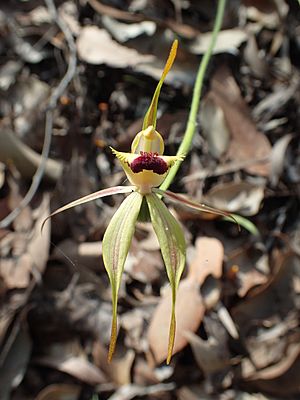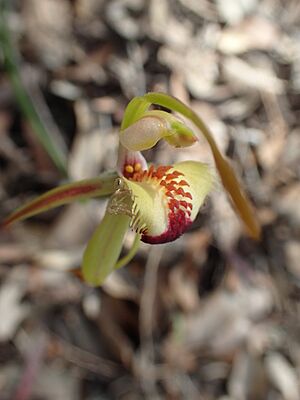Diamond spider orchid facts for kids
Quick facts for kids Diamond spider orchid |
|
|---|---|
 |
|
| Caladenia rhomboidiformis growing near Dunsborough | |
| Scientific classification | |
| Genus: |
Caladenia
|
| Species: |
rhomboidiformis
|
| Synonyms | |
The Caladenia rhomboidiformis, also known as the diamond spider orchid, is a special type of orchid. It grows only in the south-west part of Western Australia. This orchid has one tall, hairy leaf and usually one or two colorful flowers. These flowers are green, yellow, and red. For many years, scientists thought it was a different kind of orchid. It was first seen as a variety of the green comb spider orchid, Caladenia dilatata, until 1971. Then, until 1989, it was considered a variety of the clubbed spider orchid, Caladenia longiclavata.
Contents
Discover the Diamond Spider Orchid
The diamond spider orchid is a plant that grows from the ground. It comes back every year and loses its leaves in the dry season. This plant has a special underground storage part called a tuber. It grows one upright, hairy leaf that is about 120 to 180 millimeters (5 to 7 inches) long. This leaf is only about 2 millimeters (0.08 inches) wide.
What the Flowers Look Like
One or two flowers grow on a stalk that can be 200 to 450 millimeters (8 to 18 inches) tall. Each flower is about 40 to 70 millimeters (1.6 to 2.8 inches) long and 40 to 60 millimeters (1.6 to 2.4 inches) wide. The flowers have parts called sepals. These sepals have yellowish or brown tips that look like small clubs, about 2 to 10 millimeters (0.08 to 0.4 inches) long.
- The top sepal stands straight up. It is about 30 to 40 millimeters (1.2 to 1.6 inches) long.
- The side sepals point stiffly downwards. They are about 25 to 40 millimeters (1.0 to 1.6 inches) long.
- The petals are also turned stiffly downwards and spread out wide. They are about 20 to 30 millimeters (0.8 to 1.2 inches) long.
The Special Lip of the Orchid
The most interesting part of the flower is its labellum. This is a special lip that is broadly shaped like a diamond. It is about 14 to 16 millimeters (0.55 to 0.63 inches) long and 10 to 11 millimeters (0.39 to 0.43 inches) wide. The labellum is white to yellow with a bright red tip. The sides of the labellum have green, tooth-like parts up to 2 millimeters (0.08 inches) long. The very tip of the labellum curls under. There are also four rows of deep red bumps, called calli, along the middle of the labellum. This orchid usually blooms in September and October.
How the Diamond Spider Orchid Got its Name
Scientists have a special way of naming and classifying all living things. This is called taxonomy. The diamond spider orchid was first described in 1930 by a scientist named Edith Coleman. She first called it Caladenia dilatata var. rhomboidiformis.
Changing Names Over Time
Later, in 1971, another scientist, Alex George, changed its name to Caladenia longiclavata var. rhomboidiformis. Finally, in 1989, Mark Clements and Stephen Hopper decided it was unique enough to be its own species. They gave it the name Caladenia rhomboidiformis.
What the Name Means
The second part of its name, rhomboidiformis, tells us something important about the orchid. It comes from old Greek and Latin words:
- rhombos means "rhombus" (a diamond shape).
- oid means "likeness" or "like."
- forma means "shape" or "figure."
So, rhomboidiformis means "diamond-shaped," which describes the special lip (labellum) of this orchid.
Where the Diamond Spider Orchid Lives
The diamond spider orchid is found in a specific area of Western Australia. You can find it between the towns of Busselton and Augusta. It grows in special natural areas known as the Jarrah Forest and Warren biogeographic regions. This orchid likes to grow in different kinds of places. You can often find it in jarrah forests or in woodlands where Banksia or sheoak trees grow.
Protecting the Diamond Spider Orchid
The Western Australian Government Department of Parks and Wildlife keeps track of how many of these orchids are left. They have classified Caladenia rhomboidiformis as "not threatened." This means that, for now, it is considered safe and not in danger of disappearing.


